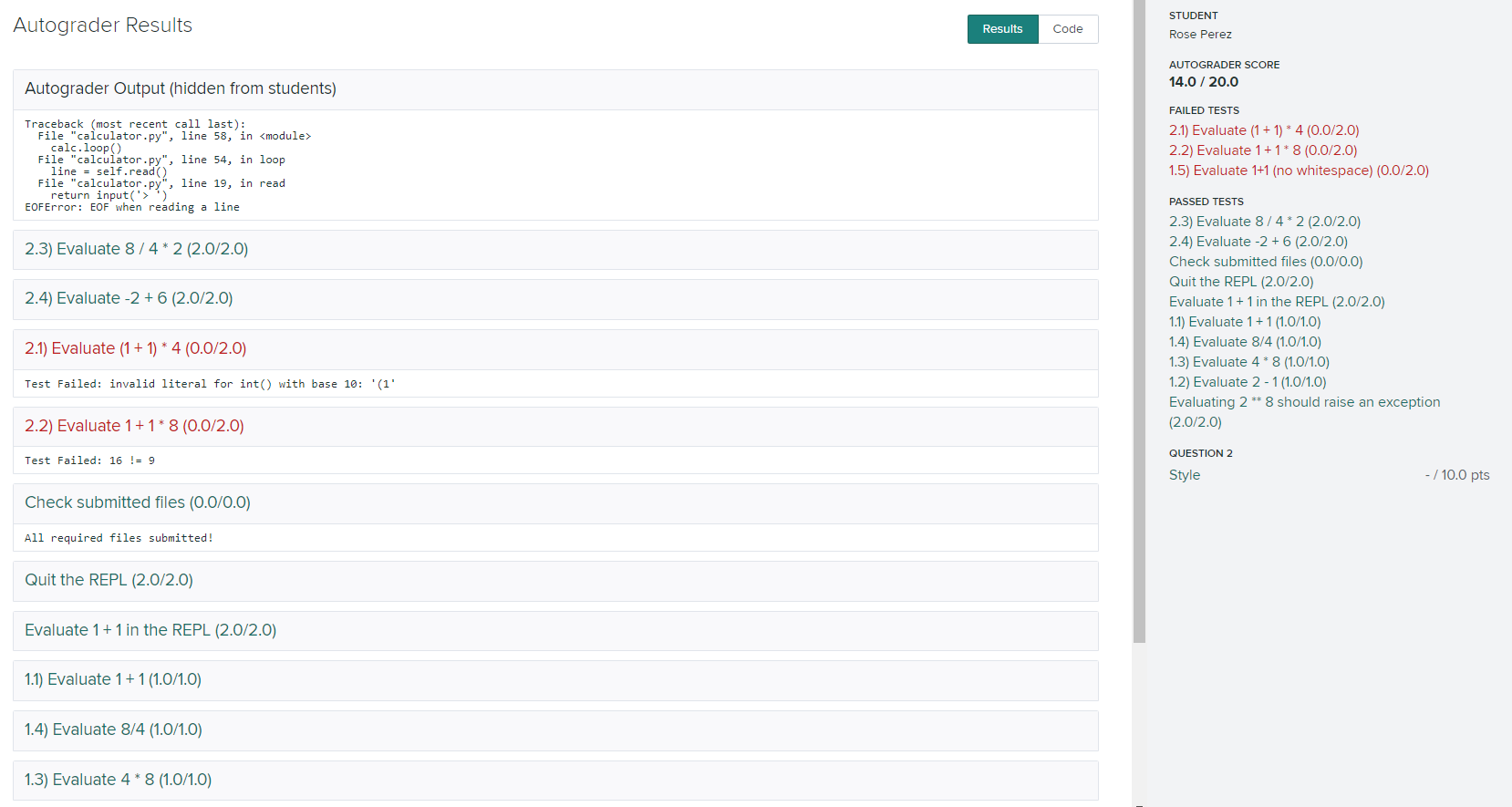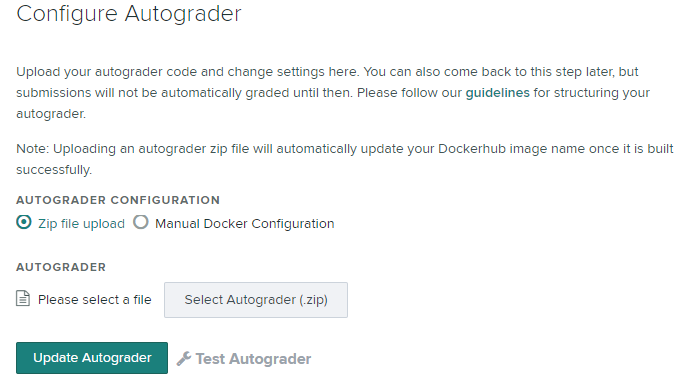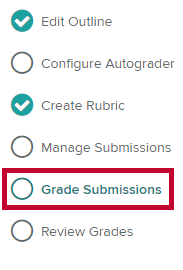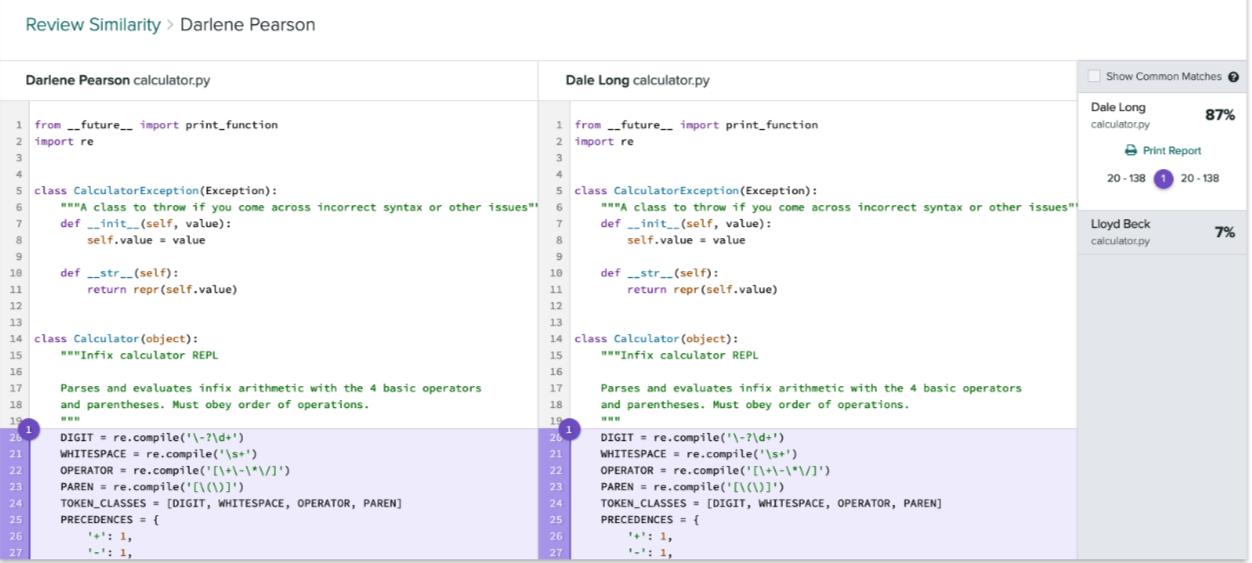About Gradescope Programming Assignments
Programming assignments can be uploaded and assessed through Gradescope. Programming Assignments accept any file type and allows students to also submit via GitHub and Bitbucket integration. Automatic and manual grading can be combined in one assignment. A code similarity tool is also available within programming assignments allows instructors to easily compare students’ submissions.
When Should I Use Gradescope Programming Assignments?
Gradescope Programming Assignments are an efficient way to collect, evaluate, and compare students’ code. In courses with multiple graders, Gradescope allows feedback to be instantly shared and updated amongst instructors and TAs. The annotations tool is particularly useful for adding feedback directly into students’ submitted code. Gradescope Programming Assignments can also be used for programming competitions through the Leaderboard option.
The Gradescope Programming Assignment Process
Create a Gradescope Programming Assignment
Instructors have two options to access Gradescope Programming Assignments – via CourseLink Integration (Content Tool) or directly through gradescope.ca using Single Sign On.
To get the most out of Gradescope and to ensure that your assignment is synced with your CourseLink site’s Classlist and connected to a corresponding grade item, it is recommended that the assignment be created through the integration. Please view our resources for Gradescope’s CourseLink Integration to learn how to create your assignment.
Once the assignment is created via the integration, it can be accessed through the link created in your course site’s Content tool, or by logging in via SSO at gradescope.ca using their School Credentials option.
Settings Options for Programming Assignments
When creating programming assignments, you are presented with the following options:
Enter an Assignment Name. When created via the CourseLink Integration, this will also be the name of the corresponding grade item and content item.
Input Autograder Points (optional). Be sure that your autograder follows Gradescope’s current specifications.
Enable Manual Grading (optional), if you will be evaluating a portion of the assignment yourself. Further information on manual grading can be found on Gradescope’s support site. Note that if you enable manual grading, you are prompted to choose your rubric creation option: create your rubric before student submission or while grading submissions.
Set a Release Date and a Due Date for student access to the assignment.
Enable Allow Late Submissions (optional), if you would like to allow students to submit after the due date has passed.
Select Enable Leaderboard for programming contests where students will be identified by pseudonyms. Explore this option in greater detail in Gradescope’s autograder documentation.
Create an Assignment Outline
From the Create Outline page, you can add question titles, sub-questions, and point values, if desired. When finished, select Save Outline.
Configure Autograder
The Gradescope Autograder quickly evaluates students’ code and provides feedback on the number of failed and passed tests in accordance with the autograder specifications.
To set up the autograder, select Configure Autograder from the lefthand toolbar. Here you can upload your autograder in a .zip file, as well as test its output. Be sure to follow Gradescope’s guidelines for structuring the autograder.
To learn more about the autograder, please visit the Gradescope Help Centre.
Add Extensions
In cases where students are scanning and uploading their work, Gradescope provides the ability to set alternative release dates, due dates, late due dates, and time limit extensions at the assignment level. Please visit the Gradescope Help Centre’s Extending dates and times on an assignment resource for more information.
Proxy Uploads
Instructors and TAs have the option to submit assignments on behalf of students. This feature is useful in cases where students miss the submission date and email the instructor their files instead. Proxy submissions permit late uploads even when the assignment does not allow late submissions from students.
- On the Manage Submissions page, select the Upload Submission button at the bottom of the page.
- From there, choose your submission method, select the student from the drop-down menu, and click the Upload button.
Grade Submissions
To begin grading, go to Grade Submissions and select the question that you would like to grade. Anyone on your Gradescope Roster with the Instructor or TA role, may participate in grading.
Gradescope rubrics
Gradescope rubrics allow instructors and TAs to grade quickly and consistently, apply the same set of feedback to every submission. Gradescope rubrics are created for each individual, manually graded question.
The main type of rubric used in Gradescope is the List View Rubric, which is made up of one or multiple Rubric Items, displayed in a vertical stack. Rubric Items contain point value (negative or positive) as well as a description for associated with each point value.
Gradescope recently introduced an option for Grid View Rubrics (beta), which are more traditional matrix style rubrics that allow you to add rows and columns of points and criteria to your rubric. As this is a beta feature, please note that you will need to request it be enabled for your Gradescope site by contacting help@gradescope.ca (be sure to include a link to your Gradescope course, not to your CourseLink course site).
Gradescope’s Help Centre provides extensive resources to help instructors and TAs with rubrics:
Creating a rubric and grading with it
Includes: Importing rubrics, item groups, and keyboard shortcuts.
Gradescope Annotations
Gradescope’s annotation tools allow graders to mark up a student’s submission. Students can see these marks, which can help them identify what part of the submission focus on. If you'd like to, you can also use LaTeX to add math symbols in comments, text annotations, answer group names, and regrade requests and responses.
Gradescope’s Help Centre provides resources to help instructors and TAs with annotations, including:
review similarity
This tool, available by clicking on the Review Similarity button on the lefthand toolbar, helps instructors easily compare students’ code. For further information, visit Gradescope’s Help Centre.
Review/Release Grades
Once you are finished grading submissions, the Review Grades page provides an overview of what was graded and allows you to:
Publish grades and feedback for student review
Includes an option to notify students via email that grades and feedback are available
hiding rubric items
By default, all rubric items are shown to students. However, in some cases it may be preferable to hide all or part of the rubric from students. You can change this from the Assignment Settings page.
For more information on the options available for showing or hiding rubric items, please visit the Gradescope Help Centre’s Hide rubric items resource.
Regrade requests
Regrade requests allow students to submit short statements about why they think their work should be given another look.
Regrade requests are enabled by default for all published assignments. However, they can be disabled by following the steps below:
- Access the Regrade Requests feature from the lefthand toolbar.
- Enable/disable the feature and check on any requests.
For a more detailed look at how Gradescope’s Regrade Requests feature works, please visit the Managing Regrade Requests page on Gradescope’s Help Centre.
Access Data and Statistics
Gradescope provides data and statistics for Programming Assignments on two levels:
Assignment Statistics
The default view showcases the averages from each question. Clicking a question’s bar within the chart will focus on it, updating the stats under the chart.
Question Statistics
If you click a question in the table below the chart, you can see that question’s statistics, showing you how often each rubric item was applied. This allows you to pinpoint difficulties or concepts that students struggled with.
More information on these options is available on the Assignment and Question Statistics page of the Gradescope Help Centre.
Useful Tips:
1. Use the Code Similarity Tool to easily compare students' code.
2. Common error messages can be resolved using Gradescope’s troubleshooting guide.
Related Videos
Related Programming
Gradescope Online Drop-ins (Tue. 10 AM / Wed. 2 PM)
Weekly Online Workshop: Get Started with Gradescope (Thu. 12 PM)
Introduction to Gradescope (03/03/2022)
Introduction to Gradescope Programming Assignments (05/06/2022)
Other Gradescope Assignment Types
Other Gradescope Scenarios
Gradescope Support
Additional Support information for Gradescope can be found on our Gradescope Support page.
If you need further assistance, please contact CourseLink Support.






















